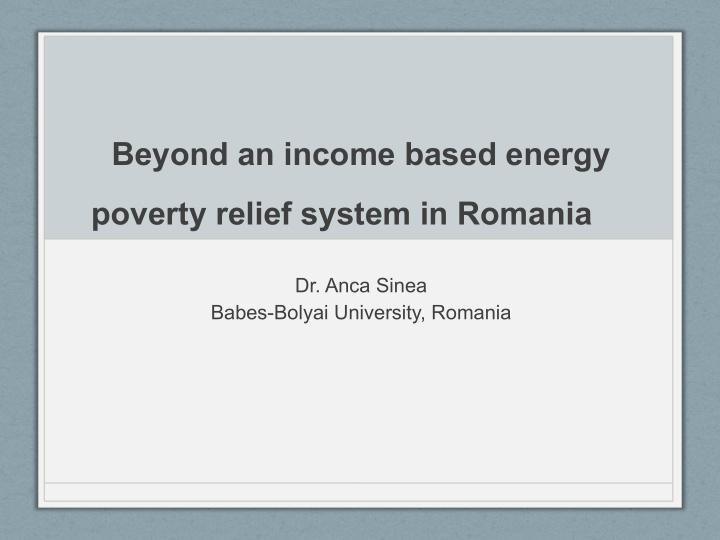



Beyond an income based energy poverty relief system in Romania Dr. Anca Sinea Babes-Bolyai University, Romania
Perspectives on Energy Poverty in Post-Communist Europe - a Routledge publication project • ”energy divide” (Bouzarovski and Tirado Herrero, 2017) • „spatial patterns” of energy poverty & the practical variations in the occurrences of energy poverty depending on the various economic, social, to some extent historic and cultural, but also political and institutional contexts and legacies (Boardman 1991, Bouzarovski and Tirado Herrero 2015, Bouzarovski and Petrova 2015) . • various communisms and transition paths (Linz and Stepan 1994)
Proposed chapters Bosnia-Herzegovina: Energy poverty facing a complex technical, economic and constitutional context in Bosnia and • Herzegovina • Bulgaria: Inconsistencies in policy-making are driving energy poverty in Bulgaria • Czech Republic: Hidden Energy Poverty. The case of the Czech Republic Germany (East vs. West) • Hungary: Trapped in politics: energy poverty in Hungary • • Lithuania: Energy poverty as heating poverty in Lithuania • North Macedonia: Energy Poverty in a subsistence-like economy Poland: Energy Poverty between energy paradigms in Poland • Romania: Beyond and income based energy poverty relief system in Romania • • Slovakia: Social inequalities and regional disparities as the framing trends in energy poverty. Lessons learned from Slovakia • Slovenia: Slovenia: the central role of NGOs in the emergence of energy poverty as a policy issue • Serbia: What to do with an insufficient state in Serbia? A private sector-lead agenda on energy poverty.
Energy poverty in conventional numbers Heating aid: 4,6% (2015) Social tariffs: 1.014.000 (14%) households (2015) 2M: 13% (2018) LIHC: 12% (2018) M/2: 15,5% (2018) Arrears on utilities (EU-SILC): 15,9% (2017) Insufficient heating(EU-SILC): 9,6% (2018) CSD: < 23% households
Beyond just the conventional numbers Energy efficiency Accessibility Residential buildings of 1961-1987 (45% brick, 30% concrete, 18% Monthly bill: Purchasing power 57%, Gini 33,1% (2017) adobe, 3% wood) Connection costs: 12-21% medium gross annual income 50% of households heat partially or temporarily Access Natural gas: 33% (44% close to the network; 78% rural uncovered) Pollution Electricity: 7136 isolated households (2019) Informal access: 422.000 households (2018) Wood: 82% rural + 12% urban Residential sector is the highest polluter District heating: 1,3 mil. households
Power structure of EP intervention tool • KEY: Local • PROBLEM: Local clashes with national • SOLUTION: Local
(Con)solid(ated) but loose system • The game of thrones: Political power/accountability and the untouchables • The system: Inefficient (biased) • The people: Unfit to deal with the challenges • A nest of opportunities (reach-out, synergies, local transitions)
Thank you!
Recommend
More recommend